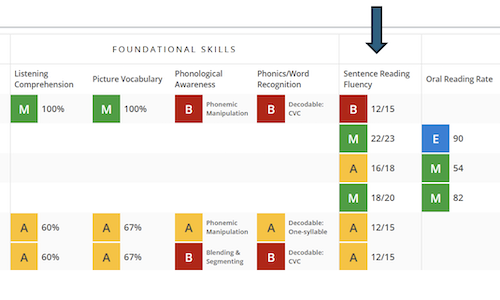 Now that the 2025 MAP® Growth™ norms are here (catch up on what’s new in my previous article), it’s time to focus on the practical side: how do you actually use these updated norms to support your students and inform your instruction?
Now that the 2025 MAP® Growth™ norms are here (catch up on what’s new in my previous article), it’s time to focus on the practical side: how do you actually use these updated norms to support your students and inform your instruction?
Think of norms as a powerful lens for making sense of test data. They provide essential context that can transform a simple RIT score into actionable insights about student progress, instructional needs, and realistic goal setting.
Making sense of achievement and growth norms
Before diving into the practical applications, let’s clarify what we’re working with when we talk about norms-informed interpretation.
Achievement percentiles tell you where a student’s current performance falls compared to grade-level peers nationally who tested in the same season. A student at the 70th percentile scored higher than 70 percent of similar students across the country. It’s a snapshot of relative standing at a specific point in time.
Growth percentiles work differently. They tell you about the rate of progress, not just current standing, by comparing how much a student grew between two test seasons to the growth of students who started at a similar achievement level. A student at the 60th percentile for growth grew more than 60 percent of students who began with comparable scores. Growth norms serve two key functions: they help you look back to evaluate whether observed growth was typical and let you look ahead to project what kind of growth is realistic for future goal setting.
The critical difference: Student vs. school norms
Here’s a place many educators (even data savvy ones!) can get tripped up, but the distinction is crucial. Student norms help you understand individual performance, while school norms help you understand aggregate performance. Mixing these up can lead to misinterpretation of your data.
Why do we need separate norms for students and schools? Here’s an analogy to explain: It’s not unusual to encounter one woman who is six feet in height. Remarkable, yes, but not unheard of. But imagine encountering a group of women where the average height is six feet. That would be extremely rare, like “Did we just walk into WNBA tryouts?” rare.
The same logic applies to test scores. Let’s say a spring math RIT score of 233 places a fourth-grader at the 90thpercentile nationally. It’s completely normal for a school to have a few students scoring that high. But if the average RIT score for an entire fourth-grade class is 233? That’s a whole different story. It could reflect something exceptional about the learning environment or it could reflect the student population that school serves. Either way, it’s a fundamentally different signal than one or two high scores.
That’s why we need different norm sets. Student norms tell us how an individual student compares to other students, and school norms tell us how a group’s average performance compares to other schools.
Using the wrong set has real consequences. If you use student norms to evaluate a school, you’ll underestimate how it compares to other schools—it’ll look more average than it really is. If you use school norms to evaluate a student, you’ll overestimate their performance—they’ll look more impressive than they actually are.
So when we say, “Use the right norm for the right purpose,” this is exactly what we mean. It’s not just a technicality; it’s the difference between fair interpretation and a misleading picture.
Using MAP Growth norms to answer key questions
Now that we’ve defined the different types of norms and clarified why using the right one matters, the next step is understanding how to put them to work. The real power of norms lies in how they transform RIT scores into meaningful information by providing context for student performance. Here are six essential questions that norms can help illuminate:
How is this student performing compared to peers nationally?
Achievement percentiles give you immediate context for interpreting RIT scores. Instead of wondering whether a 195 in fourth-grade math is good or concerning, you can see exactly where that student stands relative to grade-level peers across the country who tested in the same season. This national perspective helps you understand whether a student’s performance reflects typical achievement, suggests they’re ahead of the curve, or indicates they may need additional support.
Is this amount of growth typical for a student like this? (Looking back)
Growth percentiles help you evaluate whether a student’s progress between test seasons is above, below, or similar to peers who started at a comparable achievement level. This is especially valuable because growth expectations aren’t the same for all students. A student starting well below grade level faces different growth challenges than one starting above grade level. Growth percentiles account for these differences, giving you a fair basis for evaluating progress.
What kind of growth should we expect from this student? (Looking ahead)
Growth projections use normative data to help you set informed, realistic goals that reflect what’s typical given where a student started and how much time will pass between tests. Rather than guessing at appropriate targets, you can use projections as a starting point for goal-setting conversations, then adjust based on your knowledge of the student, available interventions, and local priorities.
How should we support this student?
Norms provide one important piece of the puzzle when making decisions about interventions, enrichment, or placement. A student consistently performing at low achievement percentiles across multiple test sessions might benefit from intensive support, while one showing high achievement might need a different type of intervention focused on engagement or challenge level. Remember, norms inform these decisions, they don’t make them for you.
How are different grades in our school performing relative to national patterns?
This is where school norms become invaluable. While student norms help you understand individual performance, school norms reveal how each grade’s aggregate achievement and growth compare to national patterns. For example, you might discover that your second-graders are at the 60th percentile while your third-graders are performing at the 40th percentile nationally. This type of pattern spurs important reflection: What’s happening between second and third grade? Are there curriculum gaps, instructional differences, or other factors affecting student progress at that transition?
School norms help you identify grade-level strengths and challenges within your building, evaluate the effectiveness of specific programs or teaching approaches, and make informed decisions about where to focus improvement efforts.
How can I talk to families about their child’s progress?
Percentiles give families relatable context for understanding their child’s performance. Most parents and guardians intuitively understand what it means to be “performing better than 65% of students nationally” in ways they might not grasp what a RIT score of 187 means.
Achievement and growth percentiles together are a particularly powerful combination for family conversations. If a child is lower on the achievement distribution but making above-average growth, that’s a positive sign they’re on track to close the gap over time. Conversely, if your high achiever is showing low growth, that’s a concerning signal that more support might be necessary, even though their current achievement looks strong. This dual perspective helps families understand both where their child stands now and the trajectory they’re on, making abstract test scores meaningful and actionable.
Putting it all together
Norms are tools, not labels. They don’t tell you what to do, but they provide powerful context to help you decide. A student at the 25th percentile shouldn’t be defined by that number. They’re a learner with specific strengths, needs, and potential that extend far beyond any single data point.
The most effective use of norms happens when you pair them with other evidence. Combine normative data with classroom observations, student work samples, local assessments, and your professional knowledge of each learner. A student showing low growth percentiles might be dealing with attendance issues, language barriers, or social-emotional challenges that require different supports than academic intervention alone. Similarly, high-achieving students with declining growth patterns might need enrichment opportunities, different instructional approaches, or simply more engaging content. The norms alert you to patterns worth investigating, then your expertise guides the response.
As you work with the 2025 MAP Growth norms, remember that they’re designed to support better decision-making, not replace professional judgment. Use them to spark questions, inform conversations, and set realistic expectations. When combined thoughtfully with other data sources and your deep knowledge of students, norms become a powerful ally in supporting every learner’s growth.
For more on the 2025 MAP Growth norms, read “Same scale, new reference: What’s new in the 2025 MAP Growth norms” and watch our on-demand webinar and our video titled “MAP Growth norms: How NWEA measures growth and achievement.”






